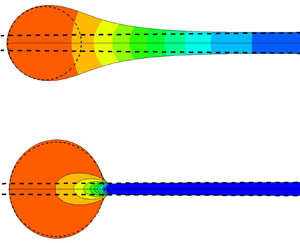Published online by Cambridge University Press: 04 September 2020

As two spherical gas bubbles of radii  $\tilde {R}$ are brought together inside a liquid of density
$\tilde {R}$ are brought together inside a liquid of density  $\tilde {\rho }$, viscosity
$\tilde {\rho }$, viscosity  $\tilde {\mu }$ and surface tension
$\tilde {\mu }$ and surface tension  $\tilde {\sigma }$, the liquid sheet separating them drains, thins and ultimately ruptures. The instant and location at which the bubbles make contact, and whereby a circular hole of vanishingly small radius is formed in the thin sheet, represent the occurrence of a finite-time singularity. The large curvature near the edge of the sheet where the hole has just formed, and where the two bubbles are now connected via a microscopic gas bridge, drives liquid to flow radially outward, causing the sheet to retract and the radius of the hole
$\tilde {\sigma }$, the liquid sheet separating them drains, thins and ultimately ruptures. The instant and location at which the bubbles make contact, and whereby a circular hole of vanishingly small radius is formed in the thin sheet, represent the occurrence of a finite-time singularity. The large curvature near the edge of the sheet where the hole has just formed, and where the two bubbles are now connected via a microscopic gas bridge, drives liquid to flow radially outward, causing the sheet to retract and the radius of the hole  $\tilde {R}_{min}$ to increase with time. Recent work in this area has uncovered self-similarity and universal scaling regimes when two bubbles coalesce in a Newtonian fluid. Motivated by applications in which the exterior is a deformation-rate-thinning, power-law fluid, recent studies on bubble coalescence in Newtonian fluids are extended to coalescence in power-law fluids. In such fluids, viscosity decreases with deformation rate
$\tilde {R}_{min}$ to increase with time. Recent work in this area has uncovered self-similarity and universal scaling regimes when two bubbles coalesce in a Newtonian fluid. Motivated by applications in which the exterior is a deformation-rate-thinning, power-law fluid, recent studies on bubble coalescence in Newtonian fluids are extended to coalescence in power-law fluids. In such fluids, viscosity decreases with deformation rate  $\dot {\tilde {\gamma }}$ raised to the
$\dot {\tilde {\gamma }}$ raised to the  $n - 1$ power where
$n - 1$ power where  $0 < n \le 1$ (
$0 < n \le 1$ ( $n = 1$ for a Newtonian fluid). Attention is focused here on power-law fluids that are slightly viscous at zero deformation rate, i.e. when the Ohnesorge number
$n = 1$ for a Newtonian fluid). Attention is focused here on power-law fluids that are slightly viscous at zero deformation rate, i.e. when the Ohnesorge number  $Oh = \tilde {\mu }_{0}/(\tilde {\rho } \tilde {R} \tilde {\sigma })^{1/2}$ is small (
$Oh = \tilde {\mu }_{0}/(\tilde {\rho } \tilde {R} \tilde {\sigma })^{1/2}$ is small ( $Oh \ll 1$) and where
$Oh \ll 1$) and where  $\tilde {\mu }_0$ is the zero-deformation-rate viscosity. A combination of thin-film theory and three-dimensional, axisymmetric computations is used to probe the dynamics in the aftermath of the singularity. Heretofore unexplored regimes are uncovered, and criteria are developed for transitions between different regimes. The existence of a truly inviscid regime, predicted long ago by Keller (Phys. Fluids, vol. 26, 1983, pp. 3451–3453) and which comes into play as a purely geometrical limit of the free-surface shape, is also reported. New insights are presented on the much studied Newtonian limit beyond the initial regime reported by Munro et al. (J. Fluid Mech., vol. 773, 2015, R3). The paper concludes with a phase diagram in
$\tilde {\mu }_0$ is the zero-deformation-rate viscosity. A combination of thin-film theory and three-dimensional, axisymmetric computations is used to probe the dynamics in the aftermath of the singularity. Heretofore unexplored regimes are uncovered, and criteria are developed for transitions between different regimes. The existence of a truly inviscid regime, predicted long ago by Keller (Phys. Fluids, vol. 26, 1983, pp. 3451–3453) and which comes into play as a purely geometrical limit of the free-surface shape, is also reported. New insights are presented on the much studied Newtonian limit beyond the initial regime reported by Munro et al. (J. Fluid Mech., vol. 773, 2015, R3). The paper concludes with a phase diagram in  $(n, \tilde {R}_{min}/\tilde {R})$-space, where the index
$(n, \tilde {R}_{min}/\tilde {R})$-space, where the index  $n$ characterizes the fluid and
$n$ characterizes the fluid and  $\tilde {R}_{min}/\tilde {R}$ the extent of coalescence, that highlights the various regimes and transitions between them.
$\tilde {R}_{min}/\tilde {R}$ the extent of coalescence, that highlights the various regimes and transitions between them.
Present address: Dow Inc., Lake Jackson, TX 77566, USA.
Present address: Convergent Science, Inc., Madison, WI 53719, USA.